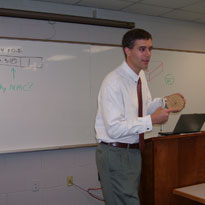GD&T – Comprehensive
- Course:GD&T – Comprehensive
- Course ID:GDT3D Duration:3 days Where: Your Office (7+ Persons)
- Download Course Description (PDF)
Available as a private, customized course for your group at your offices or ours and in some cases as a WebLive(TM) class.
Course Outline
Drawings and Dimensioning
- Importance of engineering drawings
- Fundamental dimensioning rules: 2D and 3D applications
- Review of coordinate dimensioning and tolerancing
- History of GD&T and its benefits
- Quality issues: How GD&T fits into other standards
- The current GD&T standard: ASME Y14.5-2009 (as of this outline)
Introduction to GD&T Symbols and Terms
- Definitions: Feature of size, actual local size, actual mating envelope
- Material conditions: MMC, LMC, RFS
- Radius and controlled radius
- Reading a feature control frame
Rules and Concepts of GD&T
- Rule #1: Size controls form
- Inspecting a part for size limits
- Rule #2: Implied RFS
- Bonus tolerance
- Virtual condition
- Gaging GD&T: Fixtures, special gages, CMMs
Form Tolerances
- Flatness applied to a surface
- Straightness applied to a surface
- Circularity
- Cylindricity
- Flatness and straightness applied to a feature of size
- Per-unit form control
Datums
- Purpose of datums in GD&T
- Datum vs. datum feature
- Single planar datum example
- The datum reference frame
- Feature-of-size datums
- Compound datum features
- Datum targets
- How to select datums for a part
- Simulating datums on fixtures and CMMs
Profile Tolerances
- General definition of profile
- Profile of a line
- Profile of a surface
- Profile with datum references
- Composite profile control
- Tolerance stacks; calculating min/max wall thickness
Orientation Tolerances
- Perpendicularity
- Controlling an angle with a linear tolerance
- Angularity
- Parallelism
- The tangent plane modifier
- Profile used as an orientation control
- The pitch diameter rule
Location Tolerances
- Location control with coordinate tolerances
- Definition of “true position”
- Application of position RFS
- Using the MMC and LMC modifiers
- Application of MMB and RMB on datum references
- Inspecting parts for position
- Composite position control
- Two-single-segment position control
- Projected tolerance zone
- Calculating tolerance values; fixed and floating fasteners
- Concentricity; why it is not recommended
- Symmetry
Runout Tolerances
- Definition of runout: TIR, FIM, and coaxiality
- The difference between runout and other circular controls
- Circular runout
- Total runout
Wrap-up and Review of Drawings
- Comparison with the 1994 standard
- Discussion of capability and statistics within GD&T
- Proper tolerancing strategies
- Review sample drawings
- Evaluations
Course in a Nutshell
Geometric Dimensioning & Tolerancing (GD&T) is a symbolic language used on drawings to communicate tolerancing requirements throughout the development and manufacturing process. Like any other language, it is only useful if everyone involved in the design/manufacturing process is fluent in its syntax and rules of usage. This course teaches to the latest standard (ASME Y14.5-2009 as of this outline) but can be adapted to a different version of the standard or to your own corporate standard.
This course teaches all the fundamental skills for properly applying and interpreting geometric tolerances. You will first learn the advantages of the GD&T system and how these symbols reduce the ambiguity sometimes found on prints. We will explore all the associated terms and definitions, such as MMC, virtual condition, and basic dimensions, and then examine each of the 14 geometric symbols in detail. We will also cover such topics as proper usage of datums, gaging and inspection, and calculating simple stack-ups with GD&T.
Customize It!
- We can customize the course to your group’s knowledge base as well as the types of products you work with.
- We encourage participants to bring actual prints/drawings to the class for discussion of the proper use of GD&T for your own products.
- While the course is mainly designed around the Y14.5 standard, it can be customized to accommodate other standards, such as your internal company standards.
Learn How To
- Apply proper and unambiguous dimensions and tolerances
- Interpret the feature control frame
- Calculate any “bonus” tolerance provided by the MMC/LMC modifier
- Determine the appropriate datums for a tolerance and their order of precedence
- Describe the tolerance zones defined by each symbol
- Assess the impact of a given geometric tolerance on other tolerances
- Describe appropriate inspection/gaging methods for tolerances
Aimed At
This course is aimed at those involved in mechanical design or manufacturing. Product engineers, manufacturing engineers, quality managers and inspectors, CAD operators, and mechanical designers will all benefit from this workshop.
Prerequisites
Those wishing to take this course should have a basic knowledge of blueprint reading (orthographic projection, title block/notes, simple dimensioning practices). This background may be acquired by taking the following course:
- “Liked the depth of the material, very knowledgeable instructor (there were no “hard” questions). Course text very thorough. No rock left unturned, got more than I expected.” – Dorin Balcan, Director Engineering, Zebra Technologies
- “Excellent for gaining an understanding of GD&T. Very thorough coverage of the content and the standard without getting into the minutiae. Instructor very knowledgeable and personable. Participant handbook is well-written and informative. An excellent distillation of the standard.” – Test Technician, Major US Computer Peripheral Maker
- “Once again, Eogogics has provided my team with a thorough understanding of another engineering toolset. A well prepared and educated instructor worked seamlessly with the comprehensive course workbook to keep the students engaged and leave us all with a great understanding of the subject matter.” – Greg Klein, Manager, Zebra Technologies

